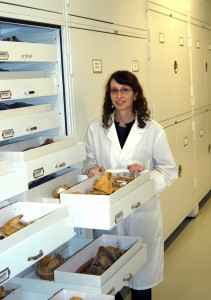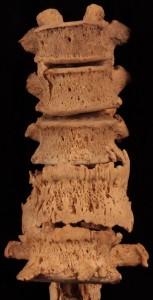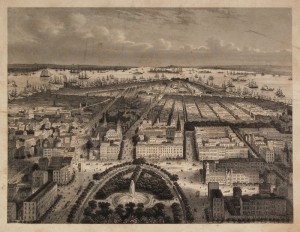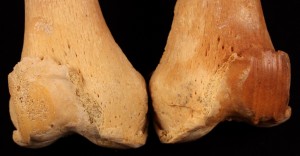Interview: Kristen Pearlstein and “An Analysis of Immigrant and Euro-American Skeletal Health in 19th Century New York City”

Kristen Pearlstein is a doctoral student at American University. In 2012, she received a Dissertation Fieldwork Grant to aid research on ‘An Analysis of Immigrant and Euro-American Skeletal Health in 19th Century New York City,’ supervised by Dr. Rachel J. Watkins. We asked Kristen to answer a few question about her grant research working with the George S. Huntington Anatomical Skeletal Collection and exploring New York City’s lost social history through the marks it left on human remains.
Let’s begin with a bit of background. Could you briefly summarize the project you undertook with your Dissertation Fieldwork Grant?
My project compares the skeletal health of European immigrants to Euro-Americans from the late 19th and early 20th centuries in order to understand the biological impact of socio-economic inequality and poverty in New York City during this time period. I evaluated the human remains of individuals who were unclaimed when they died and used as dissection cadavers for medical teaching purposes. The subjects most likely to be unclaimed were individuals who could not afford the cost of a burial, and were generally from a very impoverished segment of the population.
Skeletal health indicators from three ethnic groups – Irish, German, and Italian – were compared to health indicators from indigent U.S.-born individuals in order to determine how perceived social and economic disparities within and between immigrant and U.S.-born groups differentially impacted their skeletal health. Historical narratives show that different nationality groups had diverse experiences with discrimination and marginalization after migrating to this country. One hypothesis is that groups which experienced more prejudice had a lower health status. The Irish, for example, were maligned more than the Germans, and were more often relegated to occupations of manual labor. Therefore, I expected to observe more indicators of adverse health events in the Irish skeletal remains than in the German or U.S.-born groups. This physical evidence provides the basic data for my dissertation: the broken bones, herniated vertebral discs, tuberculous lesions, rampant systemic infections, severe arthritis, etc. I am finding that the U.S.-born group has a similar health profile to the Irish, so an interesting aspect of this study will be discerning why those similarities exist and where there are subtle differences between those two groups.
How did you originally become interested in this particular research question?
My sub-field interest is paleopathology, so my research was going to involve some aspect of human health and history. I was familiar with this particular anatomical skeletal collection from a long term rehousing project, but I did not envision the focus of this study until I took a history course on health and migration and spent time reviewing how 19th century immigrants were perceived in regards to social status and public health, with more prejudice directed toward some immigrant groups than others. I became interested in evaluating how these diverse experiences were expressed not just in the historical records, but in the actual skeletal remains. As I began my search for other studies of skeletal collections from that time period, I realized that hardly any literature expressly discussed immigrants. So I am excited that my research can contribute to this ongoing conversation about inequality and health and the experiences of different groups.

How did cultural anthropology and race theory influence your work with the physical anthropological archives?
Previous studies on anatomical and historical collections have utilized a biocultural framework to situate physical evidence within the context of the cultural environment. This project builds on existing scholarship by combining the historical narrative of social and racial/ethnic bias with the physical documentation of skeletal health. My research engages in the debate on the relationship between health and social status by examining the interactions between dominant and marginalized groups, and how these interactions are connected to health inequalities. Much of the skeletal research undertaken in biocultural health studies focuses on ethnically generalized groups, and historical studies in the United States have been carried out on African-American population samples and Euro-American population samples. These studies highlight the importance of the environmental and historical context for understanding patterns of morbidity and mortality in skeletal populations.
However, the implicit generalization of Black or White blurs additional aspects of marginalization or resistance that may contribute to health disparities within and between groups. Studies addressing the skeletal health of Whites in a historical context have not considered the stigmatization of many immigrants as ethnic ‘others’ and therefore failed to critically examine all aspects of social marginalization as it relates to health and stress. Additionally, successful studies have challenged certain assumptions we carry in regards to health and status by showing there is not always a direct correlation between skeletal health and social marginalization. So this study will seek to demonstrate how expected health outcomes in marginalized population groups are impacted by various aspects of resistance, social support, and localized stressors.

What picture of 19th century NYC emerged along the course of your research?
The City of New York had a complicated relationship with its immigrants. On the one hand, the city was totally unprepared for several million new occupants and could not provide adequate housing, sanitation, transportation, job security, or medical care. On the other hand, New York quickly became the center of American trade and industry. The immigrant and U.S.-born individuals who were migrating to New York were literally building the city from the ground up, and were producing more goods and services than just about anywhere else in the world. However, these individuals were expendable. There was very little incentive for factories or manufacturers to pay heed to occupational hazards and health consequences. If workers fell ill, they were replaced. For some occupations, unemployment was a common occurrence for several months out of the year, every year. Housing often meant small, cold apartments with no windows. Tuberculosis was still the leading cause of death, particularly among the poor. So the image I have of 19th century New York City is a very large number of people just trying to survive. But I may be biased. I spend most of my time reading about impoverished immigrants, so I cannot speak to how the upper classes were living.

What’s one thing about NYC that you think New Yorkers would be surprised to learn?
I think it would surprise many New Yorkers to learn that various ethnic groups tried to use race and ethnicity against each other to gain control of certain industries. For example, the Irish tried to take control of the docks by claiming the Germans were not white enough to work there. Both the Irish and Germans were quick to racialize the Italians as ‘other.’ We tend to idealize New York as one big ‘melting pot’ in which everyone who worked hard was quickly assimilated into the American culture. We often forget there were periods when Eastern European Jews and Italians and Irish were heavily discriminated against based on their ethnicities.
Another interesting fact about New York is that the poor were assigned the same punishment as murderers and traitors after death. Cadavers were, and are, a necessary part of medical education. As the number of medical institutions in New York grew, so did the demand for anatomical remains. Since body donations were not common, early physicians relied on illegal grave robbing and the legally obtained bodies of executed criminals to supply their anatomy classes. In the mid-19th century, the Act to Promote Medical Science expanded the legal acquisition of bodies to include unclaimed individuals from hospitals, almshouses, and other public institutions who would otherwise have been buried in a potter’s field. This meant that anyone who lacked the money for a formal burial could be used as a dissection cadaver. Essentially, the Act targeted and exploited the poor of New York, most of whom were immigrants with no political power to object, and many of whom had a very real fear of the dissection table for social and religious reasons.
What’s next for this project? Do you envision it expanding in any way?
There is more that I would love to do at the individual level with biohistorical data associated with each set of remains. I think the overall picture would be so much richer if we could find these individuals within hospital records and have a better understanding of when they were treated, what they were treated for, and how they were treated, both medically and socially. I want to know where they lived, and for the ones without recorded occupations, I want to know what they did. How big were their families? Did they board alone? It might be impossible to dig up this sort of information, but I would love to try. In terms of the skeletal remains, there is definitely more that I plan on doing. I particularly want to look at bone lesions in relation to activity. These remains exhibit a higher rate of periostitis than has been reported in other anatomical collections, and often the location of the periostitis is along an insertion site, such as where the fascia attaches between the tibia and fibula. It seems to me that inflammation in that area is more indicative of muscle activity than infection. But why is that reaction more pronounced in this particular selection of skeletons? What does it mean? I think future research for this project will delve more into fatigue, muscle overuse, and skeletal stress.